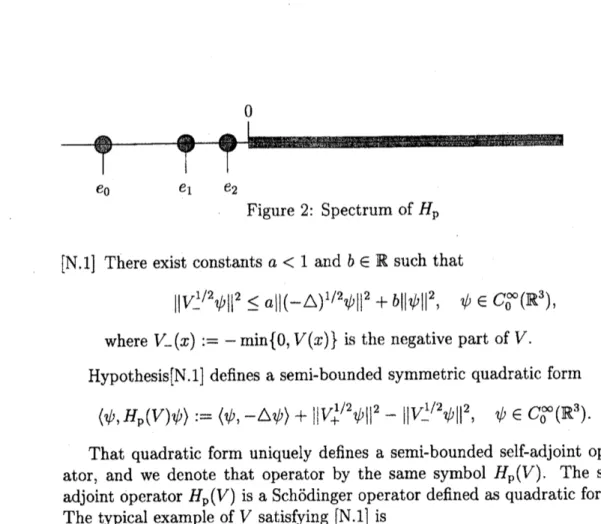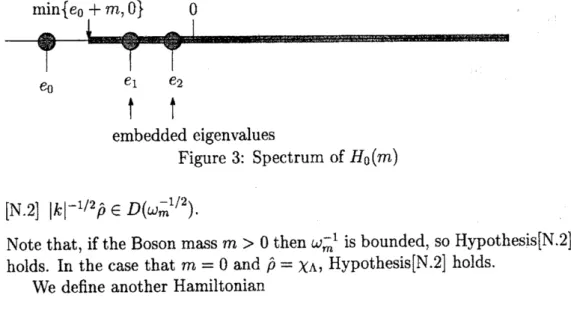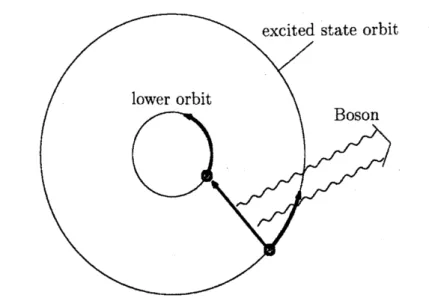Ground State
of the Nelson Model
北海道大学大学院理学研究科
佐々木 格(Itaru
Sasaki)
Department of Mathematics,
Hokkaido
University
1
The Nelson Model
We consider the ground state problem of the Nelson model. The Nelson
modelis aquantum mechanical model which describes the dynamics of
some
particle and a scalar Bose field. In this paper,
we
consider only in the casethat the particlenumber is
one.
In this paper, we consider two kind ofthe Nelson models. The first tyPe
Nelson modelis the standardNelson modelwhichappeared in [8]. The second
type is the Nelson model in
a
non-Fock representation which introduced byArai[l].
The Hilbert space of the Nelson model is defined by
$\mathcal{F}$ $:=L^{2}(\mathbb{R}^{3})\otimes \mathcal{F}_{\mathrm{b}}$, where
$\mathcal{F}_{\mathrm{b}}:=\oplus n=0\infty\ovalbox{\tt\small REJECT}\otimes_{s}^{n}L^{2}(\mathbb{R}^{3})\ovalbox{\tt\small REJECT}$
is theBoson Fock space over$L^{2}(\mathbb{R}^{3})(\mathrm{s}\mathrm{e}\mathrm{e}[10])$. Any state of the Nelson model
is described by
a
non-zero
vector in F.For the Boson
mass
$m\geq 0_{\}}$we
define a function $\omega_{m}(k):=\sqrt{k^{2}+m^{2}}$.The function $\omega_{m}(k)$ defines
a
nonnegative $\mathrm{s}\mathrm{e}_{\wedge}^{1}\mathrm{f}$-adjoint operatoron
$L^{2}(\mathbb{R}^{3})$.The $n$-Boson Hamiltonian $\omega_{m}^{[n]}$ is defined by
$\omega_{m}^{[n]}:=\sum_{\mathrm{i}=1}^{n}\mathrm{I}\otimes$
$\cdots\otimes \mathrm{I}\otimes\overline{\omega}_{m}\otimes \mathbb{I}\otimes\cdots\otimes j\mathrm{t}\mathrm{h}$ $\mathrm{I}$,
which is a self-adjoint operator
on
@:
$L^{2}(\mathbb{R}^{3})$. The free Hamiltonian of theBose field $H_{\mathrm{b}}(m)$ is defined by the direct
sum
of all $n$ Boson HamiltonianFigure 1: Spectrum of$H_{\mathrm{b}}(m)$
where $\omega_{m}^{[0]}=0$. The operator $H_{\mathrm{b}}(m)$ is
a
nonnegative self-adjoint operatoron $\mathcal{F}_{\mathrm{b}}$. The vector $\Omega:=$ $(1, 0, 0, \ldots)\in$
IFb
is unique eigenvector of $H_{\mathrm{b}}(m)$and $\sigma(H_{\mathrm{b}}(m))=\{0\}\cup[m, \infty)$ Figure 1).
For $f\in L^{2}(\mathbb{R}^{3})$
we
definea
closed operator $a(f)^{*}$on
$\mathcal{F}_{\mathrm{b}}$ by$D(a(f)^{*}):= \{\Psi\in \mathcal{F}_{\mathrm{b}}|\sum_{n=1}^{\infty}n||S_{n}f\otimes\Psi^{\langle n-1)}||^{2}<\infty\}$ ,
$(a(f)^{*}\Psi)^{(n)}.--\sqrt{n}S_{n}f$
&
$\Psi^{(n-1)}$, $\Psi$ $\in D(a(f)^{*})$,where $S_{n}$ is the symmetrization operator on $\otimes_{s}^{n}L^{2}(\mathbb{R}^{3})$. The operator $a(f)^{*}$
is called
a
creation operator. We set $a(f):=(a(f)^{*})^{*}$ the adjoint of $a(f)^{*}$.The operator $a(f)$ is called
an
annihilation operator. The operator$\Phi_{S}(f):=\frac{1}{\sqrt{2}}\overline{(a(f)+a(f)^{*})}$
is called
a
Segal field operator, and is self-adjoint. For $x\in \mathbb{R}^{3}$ and $\hat{\rho}\in$$L^{2}(\mathbb{R}^{3})\cap D(|k|^{-1/2})$
we
define $v(x)\in L^{2}(\mathbb{R}^{3})$ by$v(x)(k):=v(x, k):= \frac{1}{(2\pi)^{3/2}}\frac{\hat{\rho}(k)}{|k|^{1/2}}e^{-ik\cdot x}$
The Hilbert space $\mathcal{F}$
can
be identify with the fibre direct integral of$\mathcal{F}_{\mathrm{b}}$:
$\mathcal{F}=\int_{\mathbb{R}^{3}}^{\oplus}\mathcal{F}_{\mathrm{b}}\mathrm{d}x$ (1)
In this identification the operator
$\phi^{\oplus}(v):=\int_{\mathbb{R}^{3}}^{\oplus}\Phi_{s}(v(x))\mathrm{d}x$ (2)
gives
a
self-adjoint operator on $\mathcal{F}$. In the context of physics, the function $\hat{\rho}$is called
a
ultraviolet cutoff function. The most important example for $\hat{\rho}(k)$is$\chi_{\Lambda}(k)$ which is
a
characteristic function on theball $\{k\in \mathbb{R}^{3}||k|<\Lambda\}$. Thepositive constant A is called
a
ultraviolet cutoff,Let $V\in L_{1\mathrm{o}\mathrm{c}}^{1}(\mathbb{R}^{3})$ be a external potential for the particle. In this article,
$e_{0}$ $e_{1}$ $e_{2}$
Figure 2: Spectrum of$H_{\mathrm{p}}$
[N.1] There exist constants $a<1$ and $b\in \mathbb{R}$ such that
$||V_{-}^{1/2}\psi||^{2}\leq a||(-\triangle)^{1/2}\psi||^{2}+b||\psi||^{2}$, $\psi$ $\in C_{0}^{\infty}(\mathbb{R}^{3})$,
where $V_{-}(x):=- \min\{0, V(x)\}$ is the negative part of$V$.
Hypothesis[N.l] defines
a
semi-bounded symm etric quadratic form$\langle\psi$,$H_{\mathrm{p}}(V)\psi\}:=\langle\psi, -\triangle\psi\rangle+||V_{+}^{1/2}\psi||^{2}-||V_{-}^{1/2}\psi||^{2}$ , $\psi$
$\in C_{0}^{\infty}(\mathbb{R}^{3})$.
That quadratic form uniquely defines
a
semi-bounded self-adjointoper-ator, and we denote that operator by the
same
symbol $H_{\mathrm{p}}(V)$. Theself-adjoint operator $H_{\mathrm{p}}(V)$ is
a
Schodinger operator definedas
quadratic forms.The typical example of $V$ satisfying [N.1] is
$\mathrm{V}\{\mathrm{x})=-C/|x|$, $V(x)$ $=Cx^{2}$, $(C>0)$.
In the first(Coulomb) case, it iswell known that $H_{\mathrm{p}}$has negative eigenvalues
$\{e_{n}\}_{n=0}^{\infty}$ and $\sigma(H_{\mathrm{p}})=\{e_{n}\}_{n=0}^{\infty}\cup[0, \infty)$ (Figure 2).
We call
$H_{0}(m):=H_{\mathrm{p}}$(&I$+\mathrm{n}$ (&$H_{\mathrm{b}}(m)$,
the free Hamiltonian. $H_{0}(m)$ does not include the interaction term between
the particle and the Bose field. Therefore
we can
find spectrum of $H_{0}(m)$easily:
$\sigma(H_{0}(m))=\{\lambda+\mu\in \mathbb{R}|\lambda\in\sigma(H_{\mathrm{p}}), \mu\in\sigma(H_{\mathrm{b}}(m))\}$
$\sigma_{p}(H_{0}(m))=\{\lambda+\mu\in \mathbb{R}|\lambda\in\sigma_{p}(H_{\mathrm{p}}), \mu\in\sigma_{p}(H_{\mathrm{b}}(m))\}=\sigma_{p}(H_{\mathrm{p}})$.
In the Coulomb case,
we
draw $\sigma(H_{0}(m))$ at Figure 3.The Hamiltonian of the standard Nelson model $H_{m}^{V}$ has the following
three parts:
$H_{m}^{V}:=H_{\mathrm{p}}(V)\otimes \mathrm{I}$ $+$ II(&$H_{\mathrm{b}}(m)$ $+\phi^{\oplus}(v)$.
thesecond term$H_{\mathrm{b}}(m)$ is the freeBoson Hamiltonian withBoson
mass
$m$,and the last term $\phi^{\oplus}(v)$ is the interaction Hamiitonian between the particle
embedded eigenvalues
Figure 3: Spectrum of$H_{0}(m)$
[N.2] $|k|^{-1/2}\hat{\rho}\in D(\omega_{m}^{-1/2})$
.
Note that, if the Boson
mass
$m>0$ then$\omega_{m}^{-1}$ is bounded,so
Hypothesis[N.2]holds. In the
case
that $m=0$ and $\hat{\rho}=\chi_{\Lambda}$, Hypothesis[N.2] holds.We define another Hamiltonian
$\tilde{H}_{m}^{V}:=H_{\mathrm{p}}(V)\otimes \mathrm{I}$$+\mathrm{I}$ (&$H_{f}(m)+\phi^{\oplus}(G)-\mathcal{V}_{m}(\hat{x})\otimes \mathrm{I}$$+\mathcal{W}_{m}\mathrm{I}$, (3) where $G(x, k):=v(x, k)-v(0, k)\in L^{2}(\mathbb{R}^{3})\cap D(|k|^{-1/2})$, $\mathcal{V}_{m}(\hat{x})$ is the
multi-plication operator by the function
$\mathcal{V}_{m}(x):={\rm Re}\langle\omega_{m}^{-1/2}v(0),\omega_{m}^{-1/2}v(x)\rangle$ ,
and $\mathcal{W}_{m}:=||\omega_{m}^{-1/2}v(\mathrm{O})||^{2}$ is
a
constant (note that, by [N.2], $v(x)$,$v(0)\in$ $D(\omega_{m}^{-1/2}))$.The Hamiltonian of the quantumsystem must be self-adjoint. About the
Nelson model,
we can
easily prove the self-adjointness of these Hamiltonian:Proposition 1.1. Assume that [N. 1] and [N.2]. Then $H_{m}^{V}$ and $\tilde{H}_{m}^{V}$ is
self-adjoint
on
$D$($H_{\mathrm{p}}\otimes \mathrm{n}$$+$ It$\otimes H_{\mathrm{b}}(m)$) and bounded below. Moreover $H_{m}^{V}$ and$\tilde{H}_{m}^{V}$ is essentially self-adjoint
on
anycore
for
$H_{\mathrm{p}}$(&$\mathrm{I}$$+\mathrm{I}$$\otimes H_{\mathrm{b}}(m)$.
Definition 1.2. We saythat the
infrared
regular condition holdsif
and onlyif
$|k|^{-1/2}\hat{\rho}\in D(\omega_{m}^{-1})$,
and
we
say that theinfrared
singular condition holdsif
and onlyif
$|k|^{-1/2}\hat{\rho}\not\in D(\omega_{m}^{-1})$,
When the massive
case
$m>0$, $\omega_{m}^{-1}$ is bounded,so
the infrared regularcondition holds. In the
case
$m=0$ and $\hat{\rho}=\chi_{\Lambda}$, it is easy tosee
that$|k|^{-1/2}|k|^{-1}\chi_{\Lambda}\not\in L^{2}(\mathbb{R}^{3})$,
so
thiscase
isinfrared
singular.The following proposition
means
that infrared regular condition lead toProposition 1.3. Assume [N.1] and [N.2]. Suppose that the
infrared
regularcondition holds. Then the Hamiltonian $H_{m}^{V}$ is unitarily equivalent to $\tilde{H}_{m}^{V}$.
Proof.
By the infrared regular condition, the operator $T_{m}:=\exp[-\mathrm{i}\mathrm{N}\otimes$$\Phi_{S}(\mathrm{i}v(0)/\omega_{m})]$ is
a
unitary operatoron
$\mathcal{F}$, and we have$T_{m}H_{\mathrm{b}}(m)T_{m}^{*}=H_{\mathrm{b}}(m)-\mathbb{I}$$\otimes\Phi s(v(0))+\frac{1}{2}\langle v(0), \omega_{m}^{-1}v(0)\rangle$,
$T_{m}\phi^{\oplus}(v)T_{m}^{*}=\phi^{\oplus}(v)+{\rm Re}\langle\omega_{m}^{-1}v(0), v(x)\rangle$,
where we
use
a formula(see [2, Lemma 4-44 and $12rightarrow 5]$). Obviously $T_{m}$com-mutes $H_{\mathrm{p}}$. Therefore $\tilde{H}_{m}^{V}=T_{m}H_{m}^{V}T_{m}^{*}$ .
$\mathrm{I}$
For $\Psi\in D(H_{\mathrm{b}}(m))$,
we
definea
Fock space valued function $a(k)\Psi$ by$a(k)\Psi=(\Psi^{(1)}(k), \sqrt{2}\Psi^{\langle 2)}(k, \cdot), \ldots, \sqrt{n}\Psi^{(n\}}\langle k, \cdot)$ ,
$\ldots$).
Next
we
define a distributionon
the Fock space $\mathcal{F}_{\mathrm{b}}$ by$(a(k)^{*} \Psi)^{\langle n)}:=\frac{1}{\sqrt{n}}\sum_{j=1}^{n}\delta(k-k_{j})\Psi^{(n-1)}(k_{1}, \ldots, k_{j-1}, k_{j+1}, \ldots, k_{n})$.
Here$\delta$ is theDiracdeltafunction. Thea$(k)’ \mathrm{s}$ and$a(k)^{*}’ \mathrm{s}$satisfythe following
’formal’ CCR relations:
$[a(k), a(k’)^{*}]=\delta(k-k’)$,
$[a(k), a(k’)]=[a(k)^{*}, a(k’)^{*}]=0$.
we
define$b(k):=a(k)- \frac{1}{\sqrt{2}}\omega_{m}(k)^{-1}v(0, k)$,
$b(k)^{*}:=$
a
$(k)^{*}- \frac{1}{\sqrt{2}}\omega_{m}(k)^{-1}v(0, k)$.The second term of$b(k)$, $b(k)$’ is constant foreach $k\in \mathbb{R}^{3}$
.
Hence $b(k)’ \mathrm{s}$ and$b(k)^{*}’ \mathrm{s}$ satisfy the formal
CCR
relations:$[b(k), b(k’)^{*}]=\delta(k-k’)$,
$[b(k), b(k’)]=[b(k)^{*}, b(k’)^{*}]=0$.
By using $a(k)$,
we
write the Hamiltonian $H_{m}^{V}$as
$\langle\Psi, H_{m}^{V}\Psi\rangle=\langle\Psi, H_{\mathrm{p}}\otimes \mathrm{X}\Psi\rangle$ $+ \oint_{\mathbb{R}^{3}}\omega_{m}(k)\langle$$\mathrm{I}\otimes a(k)\Psi$, I$\otimes a(k)\Psi\rangle$$\mathrm{d}k$
and $\overline{H}_{m}^{V}$
can
be writtenas
$\langle\Psi,\tilde{H}_{m}^{V}\Psi\rangle=\langle\Psi, H_{\mathrm{p}}\otimes 1\Psi\rangle$$+ \int_{\mathbb{R}^{3}}\omega_{m}(k)\langle \mathbb{I}\otimes b(k)\Psi, 1 \otimes b(k)\Psi\rangle \mathrm{d}k$
$+ \int_{\mathbb{R}^{3}}\frac{\hat{\rho}(k)}{|k|^{1/2}}[\langle e^{-ik\hat{x}}\otimes b(k)\Psi, \Psi\rangle+\langle\Psi, e^{-ik\hat{x}}\otimes b(k)\Psi\rangle]\mathrm{d}k$,
$a(k)$,$a(k)$’ is called the Fock representation of the
CCR.
When thein-frared regular condition holds, $b(k)$,$b(k)^{*}$ is unitarily equivalent to the Fock
representationofthe CCR, but in the infrared singular case, $b(k)$,$b(k)^{*}$ is not
unitarily equivalent to the Fock representation of the CCR(see [2, p.202]).
By this reason, when the infrared singular condition holds, we call that the
operator $\tilde{H}_{0}^{V}$ is the Nelson Hamiltonian in
a
non-Fock representation.2
Existence
of
Ground
State
Let $H$ be self-adjoint and bounded from below. We call the real value
$\mathrm{E}\mathrm{O}(\mathrm{H})=$ $\mathrm{a}(\mathrm{H})$ the ground (state) energy of $H$. If $E_{0}(H)$ is
an
eigen-value of$H$, the corresponding eigenvector is called
a
ground stateof$H$.
Weset
$E^{V}(m):= \inf$a$(H_{m}^{V})$, $\tilde{E}^{V}(m):=\inf$
a
$(\overline{H}_{m}^{V})$the ground state
energy
of$H_{m}^{V}$ and $\overline{H}_{m}^{V}$ respectively.Proposition 2.1. Assume $[NJ]$ and [N.2]. Then
$E^{V}(m)=\tilde{E}^{V}(m)$
for
all$m\geq 0$.Proof.
In thecase $m>0$
, by Proposition 1.3, $H_{m}^{V}$ is unitarilyequiva-lent to $\tilde{H}_{m}^{V}$. Hence $E^{V}(m)=\overline{E}^{V}(m)$ for $m>0$. Let
$m>m’>0$
,then we have $H^{V}(m)$ $\geq H^{V}(m’)\geq H^{V}(0)$. Therefore, by the variational
principle $E^{V}(m)\geq E^{V}(m’)\geq E^{V}(0)$
.
Hence $\lim_{marrow+0}E^{V}(m)$ exists, and$\lim_{marrow+0}E^{V}(m)\geq E^{V}(0)$. It iseasyto
see
that $\lim_{marrow+0}H_{m}^{V}\Psi=H_{0}^{V}\Psi$ for all $\Psi\in D(H_{\mathrm{p}})\otimes D(H_{\mathrm{b}}(\wedge 0))$, where $\otimes\wedge$means
algebraic tensor product. Therefore$H_{m}^{V}$ converges to $H_{0}^{V}$ in the strong resolvent
sense.
([9, Theorem VIIL25]).Similarly $\overline{H}_{m}^{V}$
converges
to $\tilde{H}_{0}^{V}$ strong resolventsense.
Hencewe
have theinverse inequality $\lim_{marrow+0}E^{V}(m)\leq E^{V}(0)$ and $\lim_{marrow+0}\overline{E}^{V}(m)\leq\tilde{E}^{V}(0)1$
Figure
4:
All excited statesare
unstableThe problem
we
consider here isProblem. Do $H_{m}^{V}$ and $\tilde{H}_{m}^{V}$ have
a
ground state?In the
case
$m>0$, the free Hamiltonian$H_{0}(m)$ hasa
discrete groundstate(see Figure 3). Therefore by the regular perturbation theory, the massive
Hamiltonian $H_{m}^{V}(m>0)$ has a ground state for sufficiently small $||\hat{\rho}||$. But
we
show that the massive(m $>0$) Hamiltonian $H_{m}^{V}$ hasa
ground state for allcoupling constant $||\hat{\rho}||$. In the proof about existence ofmassive ground state,
we
use
a localization estimate techniquewhich is developed by M. Griesemer,E. Lieb, and M. Loss [4]. The condition to have a ground state
we
give hereis essentially
same
as GLL criterium[4], butour
condition contains thecase
ofthe oscillator(V $=Cx^{\alpha}$, ($C$,$\alpha>0$)).
In the massless
case
$m=0$, alleigenvalueofthefree Hamiltonian$H_{0}(m=$$0)$ embedded in the continuum(Figure 3),
so we can
not apply the regularperturbation theory for any perturbation.
Since
the embedded eigenvaluemay vanish by
any
small perturbation, the analysis ofground state for $H_{0}^{V}$,$\overline{H}_{0}^{V}$ is difficult.
When there is
no
interaction between the Bose field and the particle, allexcitedstates
are
stable becausetheyare
eigenvectorsofthefree Hamiltonian$H_{0}(m=0)$. However, when the particle interact with the Bose field, the
excitedstate particleshouldemit
a
Boson and falltoa
lower orbit (see Figure4). Actually, in
an
atom, any excitedstate electronemits light spontaneouslyand falls to
a
lower orbit. Namely, all excited states should be unstable.state energy.
Incidentally, for
a
natural potential $V$, 1 believe that the Hamiltonian$H_{0}^{V}$ and $\tilde{H}_{0}^{V}$ have
no
singular continuous spectrum. Then all spectrum ofthe Hamiltonian is absolutely continuous spectrum if the Hamiltonian has
no
ground state. In this situation, for any state $\Psi\in \mathcal{F}$, the time evolutionof $\Psi$ converge weakly to
0
by the Riemann-Lebesgue Theorem, which isa
contradiction. Because, the particle must remain
near
the originas
Figure4.. Therefore ifthe particleHamiltonian $H_{\mathrm{p}}$hasground state andthe Nelson
modelisphysicallynatural, theHamiltonian oftheNelson model should have
a
ground state.In 2001, A. Arai showed that the Nelson Hamiltonian in a non-Fock
rep-resentation $\tilde{H}_{0}^{V}$ has
a
ground state, if $V(x)\geq c|x|^{\alpha}$, $c$,$\alpha-2\geq 0$ and theinfrared singular condition holds(see[l]).
However, J. Lorinczi, R. A. Minlos and H. Spohn showed that if$V(x)\geq$
$c|x|^{a}$, $c$,
a–2
$\geq 0$ then the standard massless Nelson Hamiltonian $H_{0}^{V}$ hasno
ground state in the infrared singular case([7]).In Mathematically, the existence of ground state is a phenomenon
de-pending
on
the representation ofthe CCR. In the context of this article, inthe infrared singular case, the Arai’s Nelson Hamiltonian $\tilde{H}_{0}^{V}$ is physically
natural
more
than the standard Nelson Hamiltonian $H_{0}^{V}$.Let $\theta\in C_{0}^{\infty}(\mathbb{R}^{3}),\tilde{\theta}\in C^{\infty}(\mathbb{R}^{3})$ be functions which satisfy the following
properties (i), (ii):
(i) $0\leq\theta(x),\tilde{\theta}(x)\leq 1$, $\theta(x)^{2}+\overline{\theta}(x)^{2}=1$, $x\in \mathbb{R}^{3}$
.
(ii) $\theta(x)=\{$1,
$|x|\leq 1$,
0, $|x|\geq 2$
.
For $R>0$
we
define particle cutofffunctions $\theta_{R},\tilde{\theta}_{R}$as
follows:$\theta_{R}(x):=\theta(x/R)$, $\tilde{\theta}_{R}(x):=\theta(x/R)$.
We abbreviate $\theta_{R}\otimes \mathrm{I},\tilde{\theta}_{R}\otimes \mathrm{n}$ to $\theta_{R},\tilde{\theta}_{R}$
.
We define a minimal energy in thestate where the particle is separated
more
than $R$ away from the origin:$E_{\infty}(R, m):= \Psi_{\frac{\in}{\theta}}Q(H_{m}^{V})\}|\inf_{R^{\Psi||\neq 0}}\frac{\langle\overline{\theta}_{R}\Psi,H_{m}^{V}\overline{\theta}_{R}\Psi\rangle}{||\overline{\theta}_{R}\Psi||^{2}},\tilde{E}_{\infty}(R, m):=\Psi Q(_{m^{)}}11_{R^{\Psi||\neq}}^{\frac{\in}{\theta}}\mathrm{i}\mathrm{n}_{\frac{\mathrm{f}}{H}\mathrm{v}_{0}}\frac{\langle\overline{\theta}_{R}\Psi,\tilde{H}_{m}^{V}\tilde{\theta}_{R}\Psi\rangle}{||\overline{\theta}_{R}\Psi||^{2}}$ ,
where $Q$
means
the form domain. Note that $E_{\infty}\underline{(}R$,$m$) and$\overline{E}_{\infty}(R, m)$
are
have $E_{\infty}(R, m)$ $=\tilde{E}_{\infty}(R, m)$. By the variational principle,
we
have$E_{\infty}(R, m)\geq E^{V}(m)$, $\tilde{E}_{\infty}(R, m)\geq\tilde{E}^{V}(m)$,
for all $m\geq 0$
.
Definition 2.2 (binding condition). We say the inequality
$E^{V}(m)< \lim_{R\prec}\sup_{\infty}E_{\infty}(R, m)$
the binding condition.
Now
we
state that the existence theorem ofthe massive Nelson model;Theorem
2.3
(Existence ofground state $(m>0)$). Let$m>0$.Assume
that[N. 1] and $[N.2]$ hold. Suppose that the binding condition
for
$m>0$ holds.Then $H_{m}^{V}$ has
a
groundstate.Proof.
This proof is basedon
[4]. In this proof,we
take the spacerepresen-tation for the Bosons. Namely,
we
consider$\hat{H}:=\mathrm{I}\otimes\Gamma(\mathcal{F}^{-1})H_{m}^{V}$I$\otimes\Gamma(\mathcal{F})$
$=H_{\mathrm{p}}\otimes \mathrm{n}$$+\mathrm{n}$$\otimes \mathrm{d}\Gamma_{\mathrm{b}}(\sqrt{-\triangle+m^{2}})+\phi^{\oplus}(\mathcal{F}^{-1}v)$,
where $\mathcal{F}$ is the Fourier transform
on
theone
Boson space, $\Gamma$ is the secondquantizationofsecond type, $\mathrm{d}\Gamma_{\mathrm{b}}$is thesecond quantizationoperator (see [2]),
and
$( \mathcal{F}^{-1}v)(x, y)=\frac{1}{(2\pi)^{3}}\int_{\mathbb{R}^{3}}\frac{\hat{\rho}(k)}{|k|^{1/2}}e^{-ik(x-y\}}\mathrm{d}k$,
where $x$ is the coordinate of the particle, and $y$ is the coordinate of the
Boson. For $P>0$
we
set $j_{1}(y):=\theta(y/P)$, $i_{2}(y):=\tilde{\theta}(y/R)$ the Boson cutofffunctions. We define
a
new
creation and annihilation operators$c(f):=a(j_{1}f)\otimes 1$$+\mathrm{I}$$\otimes a(j_{2}f)\}$
$c(g)^{*}:=a(j_{1}g)^{*}\otimes 1$ $+\mathrm{I}$
&
$a(j_{2}g)^{*}$, $f$,$g\in L^{2}(\mathbb{R}^{3})$,which is
a
closed operatoron
$\mathcal{F}_{\mathrm{b}}\otimes \mathcal{F}_{\mathrm{b}}$. Let$\mathcal{F}_{\ell}:=\overline{\mathcal{F}_{\ell,\mathrm{f}\mathrm{i}\mathrm{n}}}\subseteq \mathcal{F}_{\mathrm{b}}\otimes \mathcal{F}_{\mathrm{b}}$,
$\mathcal{F}_{\ell,\mathrm{f}\mathrm{i}\mathrm{n}}:=\mathcal{L}\{\Omega\otimes\Omega, c(g_{1})^{*}\cdots c(g_{k})^{*}\Omega\otimes\Omega|g_{j}\in L^{2}(\mathbb{R}^{3}),j=1_{7}\ldots, k, k\in \mathrm{N}\}$.
We define
a
operator $U_{0}$ : $\mathcal{F}_{\mathrm{b}}arrow \mathcal{F}_{\mathrm{b}}\otimes \mathcal{F}_{\mathrm{b}}$ by$D(U_{0}):=\mathcal{F}_{\mathrm{f}\mathrm{i}\mathrm{n}}$,
where $\mathcal{F}_{\mathrm{f}\mathrm{i}\mathrm{n}}$
means
the finite particle subspace (see [2]). It iseasy to see that$U_{0}$ is isometry, and $U:=\overline{U_{0}}$ is isometric operator from $\mathcal{F}_{\mathrm{b}}$ to $\mathcal{F}_{\mathrm{b}}\otimes \mathcal{F}_{\mathrm{b}}$ with
Ran(U) $=\mathcal{F}_{\ell}$. Therefore
$U^{*}U=\mathrm{I}_{F_{\mathrm{b}}}$, $UU^{*}=$ orthogonal projection
on
$\mathcal{F}_{\ell}$.We define adense space by $V$ $:=C_{0}^{\infty}(\mathbb{R}^{3})\otimes \mathcal{F}_{\mathrm{f}\mathrm{i}\mathrm{n}}(C_{0}^{\infty}(\mathbb{R}^{3})\wedge)$. By the IMS
local-ization formula, we have that
$\hat{H}=\theta_{R}\hat{H}\theta_{R}+\tilde{\theta}_{R}\hat{H}\tilde{\theta}_{R}-\frac{1}{2}|\nabla\theta_{R}|^{2}-\frac{1}{2}|\nabla\tilde{\theta}_{R}|^{2}$ , (4)
in the
sense
of quadratic formon
$\prime D$. The key of the proof is the followinglemma
Lemma 2.4. For all $\Psi\in D_{f}$ we have that
$\langle\Psi, \theta_{R}\hat{H}\theta_{R}\Psi\rangle=\langle\Psi, \theta_{R}U^{*}\{\hat{H}\otimes \mathrm{I}_{\mathcal{F}_{\mathrm{b}}}+1_{F}\otimes H_{\mathrm{b}}(m)\}U\phi_{R}\Psi\rangle$
$+o(1)\langle\Psi, (\hat{H}-E^{V}(m)+1)\Psi\rangle$,
in the
sense
of
quadratic form, where the operator in $\{\}$ is acting on theHilbert space$\mathcal{F}\otimes \mathcal{F}_{\mathrm{b}}$, and$o(1)$ is a constant such that$\lim_{Rarrow\infty}\lim_{Parrow\infty}o(1)=$
$0$
.
We omit the proof of this Lemma(see [4]). By this lemma and (4),
we
have
$\hat{H}\geq\theta_{R}U^{*}\{E^{V}(m)\otimes \mathrm{I} +\mathrm{n} (\otimes m(1 -P_{2})\}U\theta_{R}$
$+E_{\infty}(R,m)\overline{\theta}_{R}^{2}+o(1)$(ff $-E^{V}(m)+1$),
in the
sense
ofquadratic formon
$\prime D$, where $P_{2}$ is the orthogonal projectionon
Q. Therefore$\hat{H}-E^{V}(m)\geq(E_{\infty}(R, m)-E^{V}(m))\theta_{R}^{\tilde{2}}+m\theta_{R}^{2}-m\theta_{R}U^{*}I\otimes P_{2}U\theta_{R}$
$+o(1)(\hat{H}+\mathrm{I})$
.
Note that $T$ $:=\theta_{R}U^{*}1\otimes P_{2}U\theta_{R}=(\Gamma(j_{1})\theta_{R})^{2}$
.
Since
$H_{\mathrm{b}}(m)$ is massive, hence$T$ is ($-\triangle\otimes$ II $+\mathrm{I}$ $\otimes H_{\mathrm{b}}(m)+1$)-form compact(more precisely
see
[4]). By$\theta_{R}^{2}+\theta_{R}^{\tilde{2}}=1$,
we
have that$(E_{\infty}(R, m)-E^{V}(m)) \theta_{R}^{\tilde{2}}+m\theta_{R}^{2}\geq\min\{E_{\infty}(R, m)-E^{V}(m), m\}$.
Therefore
we
getin the
sense
of the quadratic formon
$Q(\hat{H})$, wherewe
done the closedex-tension of the quadratic form. Using the condition $[\mathrm{N}.\mathrm{I}],[\mathrm{N}.2]$,
one can
show that $T$ is $\hat{H}$ -form compact. So $T$ does not change the essential spectrum of$H_{\ovalbox{\tt\small REJECT}}$ and hence
$(1-o(1)) \Sigma(\hat{H})-E^{V}(m)\geq\min E_{\infty}(R, m)-E^{V}(m)$,$m+o(1)$, (5)
where $\Sigma$
means
the bottom ofthe essential spectrum. Nowwe
take the limit$\lim_{Rarrow\infty}\lim_{Parrow\infty}$, and
we
get$\Sigma(\hat{H})-E^{V}(m)>0$.
This inequality
means
that $\hat{H}$ hasa
discrete ground state.1
For existence of the massless ground state,
we
assume
these followingconditions:
[N.3] There exists
an
open set $S\subset \mathbb{R}^{3}$, such thattt $\mathrm{s}\mathrm{u}\mathrm{p}\mathrm{p}/5=\overline{S}$. Moreover, forall $n\in \mathrm{N}$
$S_{n}:=\{\mathrm{i}\in S||k|<n\}$
has the cone-property (see [6]).
[N.4] There exists a function y7 $\in H^{1}(\mathbb{R}^{3})$, such that $\hat{\rho}=\chi s\eta$.
[N.5] $\hat{\rho}$ is continuously differentiate in $S\backslash \{0\}$.
[N.6] $|k|^{-3/2}\hat{\rho}$, $|k|^{-1/2}|\nabla\hat{\rho}|\in L^{p}(S)$ for all $p\in(1,2)$.
Theorem 2.5 (Existence of ground state $m=0$). Let $m=0$. Assume
conditions$fN.l$]$-[N.\theta]$
.
If
the binding condition holds, then $\tilde{H}_{0}^{V}$ has a groundstate.
Remark. If$\lim$
}$x|arrow\infty V(x)=\infty$, one can show that $\lim_{Rarrow\infty}E_{\infty}(R, m)=\infty$.
Therefore the binding condition holds. If$\lim|x|arrow\infty V(x)$ $=0$, $V\in L_{1\mathrm{o}\mathrm{c}}^{2}(\mathbb{R}^{3})$ and $H_{\mathrm{p}}$ has
a
negative ground state. Then the binding condition holds (see[4, Theorem 3.1]$)$
.
Remark. $\hat{\rho}=\chi_{\mathrm{A}}$ satisfies the conditions [N.$1$]$-[\mathrm{N}.6]$.
References
[1] A. Arai, Ground state of the massless Nelson model without infrared
cutoffin
a
non-Fock representation, Rev. Math. Phys. 9 (2001),1075-191
[2] A. Arai, Fock spaces and Quantum fields (Nippon-Hyouronsya, Tokyo,
2000) (in Japanese).
[3]
C.
G\’erard, On the existence ofground states for massless Pauli-FierzHamiltonians, Ann. Henri Poincare 1 (2000),
443-459.
[4] M. Griesemer, E. Lieb and M. Loss, Ground states in non-relativistic
quantum electrodynamics, Invent math. 145 (2001), 557-595.
[5] M. Hirokawa, F. Hiroshimaand H. Spohn, Ground states forpoint
par-ticles interacting through a massless scalar bose field, Adv. Math. 191
(2005), 339-392.
[6] E. H. Lieb, M. Loss, Analysis, Amer. Math. Soc. second edition, 2001.
[7] J. Lorinczi, R. A. Minlos and H. Spohn The infrared behaviour in
Nel-son’s model of
a
quantum particle coupled to a massless scalar field,Ann. Henri Poincare 3 (2002), 269-295.
[8] E. Nelson, “Interaction of nonrelativistic particles with
a
quantizedscalar field”, J. Math. Phys. 5 (1964)
1190-1197.
[9] M. Reed and B. Simon, Methods ofModern Mathematical Physics Vol.
I, Academic Press, New York, 1972.
[10] M. Reed and B. Simon, Methods of Modern Mathematical Physics Vol.
II, Academic Press, New York,
1975.
[11] M. Reed and B. Simon, Methods ofModern Mathematical Physics Vol.
IV, Academic Press, NewYork,
1978.
[12] I. Sasaki, Ground state of the massless Nelson model in a non-Fock
representation, J. Math. Phys. 46, (2005)
[13] H. Spohn, Groundstates of


